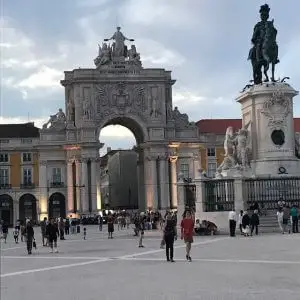
Updated February 26, 2023. Here is a fun and efficient itinerary for 48 hours in Lisbon.
48 Hours in Lisbon: Day 1
- Castelo de São Jorge
- Walk through the Alfama neighborhood
- Scenic viewpoints – Miradouro da Santa Luzia and Miradouro das Portas do Sol
- Sé Cathedral
- Eat Pastéis de Nata
- Eat fresh seafood
- Lisbon Oceanarium? Tile museum?
- Sunset in Baixa
- Nightlife Pink Street?
48 Hours in Lisbon: Day 2
- Take Tram 28
- Jerónimos Monastery
- Monument to the Discoveries
- Belém Tower
- Lunch at Timeout Market
- Convento do Carmo
- Explore Bairro Alto and Príncipe Real
- Sunset at the the Miradouro de São Pedro de Alcântara? Another option might be a sunset cruise
- Nightlife Bairro Alto and Príncipe Real
This list packs a lot of sites and activities into 48 hours in Lisbon.
I have included all of the must-sees which I discussed in my article, Lisbon 24 hour checklist – what should I see and do?, and I have mentioned some of my other favorite things you should see in Lisbon.
The must-see sites are now spread over two days, and I have added in other interesting things to see as well.
If you want to skip something or move at a slower pace, that’s fine too.
I recommend that you travel light – only with a carry-on if possible.
This will allow you to quickly move from the airport to the airport metro station, and then to the historic Baixa district downtown (Rossio Square, metro green line), which is very central.
In advance, you can purchase a Lisboa Card for free use of public transportation and free and discounted admission to certain sights. See my Lisboa Card | Everything you need to know
Or, at the metro station, you can buy a Viva Viagem transport card and put a cash balance on it so that you can easily use public transportation.
I suggest a hotel in the Baixa or on Avenida da Liberdade to be more efficient in moving around the city. Hotels located near metro stations in Lisbon
Lisbon 48-hour itinerary: Day 1
Castelo São Jorge
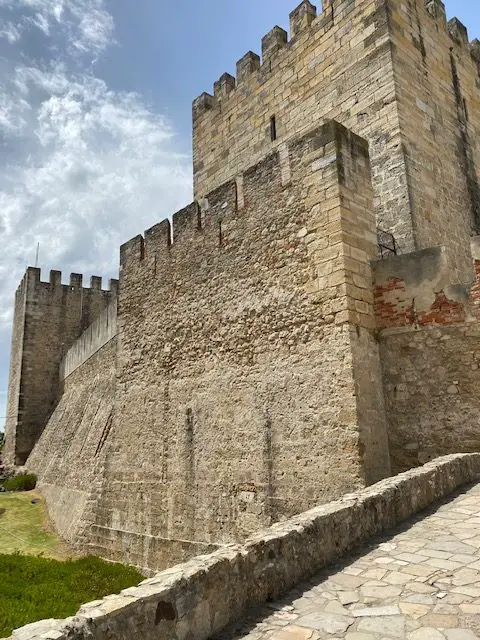
In and around Castelo de São Jorge – Lisbon’s castle
Admission: €10
The castle is the oldest structure in Lisbon, and it is Lisbon’s most visited site.
There has been a settlement on this hilltop since before the time of Christ.
The Muslim Moors held this hilltop and constructed a fortress here in the seventh century.
Afonso Henrique organized and led Christian knights to retake the hilltop from the Moors in 1147.
Shortly after, he became the first King of Portugal.
The castle was badly damaged in the earthquake of 1755.
Take bus 737 from Praça da Figueira to the castle door.
Spend an hour or two exploring the castle, taking in the views, and watching the peacocks that live on the castle grounds.
Explore the Alfama neighborhood
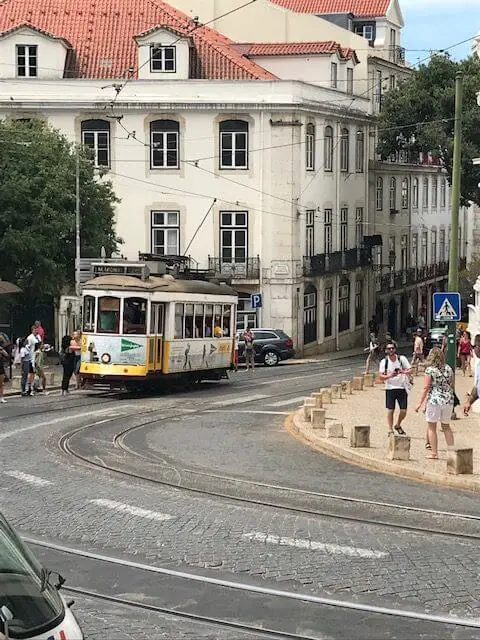
As you walk through the Alfama neighborhood, we will do a little scavenger hunt.
Your mission is to find and consume two uniquely Portuguese products in Lisbon’s oldest neighborhood (Don’t go out of your way looking for them though, just purchase them when you notice them pop up).
The first product is ginja, or ginjinha.
This is a local cinnamon, sugar, and brandy-type liquor.
It sells in a small cup for or €1.25.
Your questions about Ginjinha answered here
Also, look for any bakery, pastry shop, coffee shop, or sandwich shop that sells a custard tart called a pastel de nata (pastéis de nata = plural).
This pastry was invented in Lisbon by the monks at the Jerónimo‘s Monastery several hundred years ago.
Hint: As you exit the castle, go to your right. At the bottom of the street, the attractive builing with the tiled facade, is the Pastelaria de Santo António. This award-winning shop sells the gooiest pastel de nata in Lisbon.
Enjoy the views on the way down
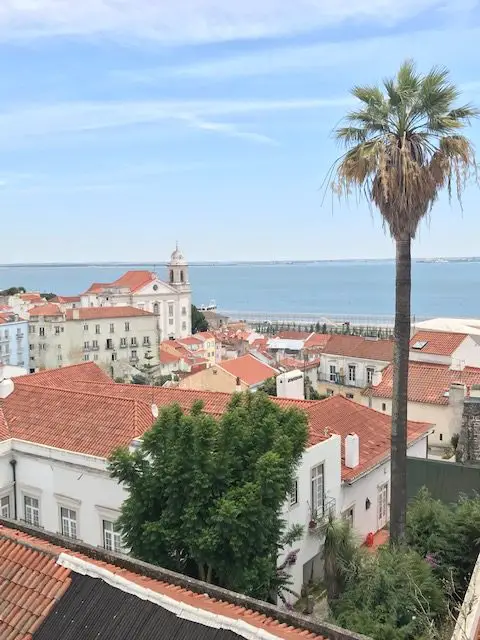
As you walk downhill you will run into the Miradouro (scenic viewpoint) das Portas do Sol.
GPS Coordinates 38.711899,-9.129996 For more information read my Miradouro Portas do Sol viewpoint – What you need to know
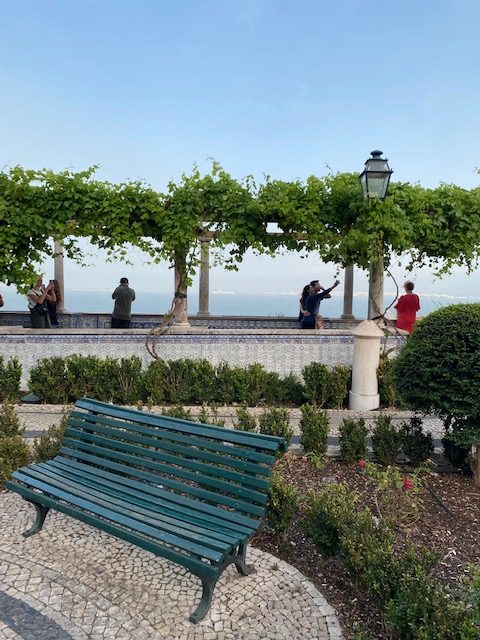
Also, take time to enjoy the free Miradouro da Santa Luzia at Largo de Santa Luzia. It is located another 50 yards downhill.
GPS Coordinates 38.71192,-9.13026.
Read my article Miradouro de Santa Luzia – one of the best places to take photos in Lisbon
Sé de Lisboa Cathedral
GPS 38.70985° N, -9.132983° E
Largo da Sé
The oldest and most important church in the city – Lisbon Cathedral, or Sé Cathedral, was built on the site of a mosque in 1147.
The Gothic cathedral is very solid and survived all of Lisbon’s earthquakes.
Windows in the church reveal archaeological digs showing Roman, Moorish, and Visigoth artifacts.
In addition, St. Anthony was baptized in this church, and his relics are kept here.

In addition, St. Anthony was baptized in this church, and his relics are kept here.
Admission to the church is free. There are usually people inside praying.
Silence and respectful dress are expected from visitors.
Continue to the bottom of the hill.
Eat seafood at Cervejaria Ramiro

Lisbon is known for its fresh seafood and shellfish.
| Brewery Ramiro | Brewery Lisbon (cervejariaramiro.com) is one of my favorite restaurants in Lisbon.
Don’t worry that they call themselves a brewery. It is probably one of the top seafood restaurants in the world.
If you go at lunchtime there should not be a long line to get in.
One of my favorite items on the menu is ameijoas a bulhão pato, clams in a white wine and garlic sauce.
Crab, crab legs, and tiger prawns (huge shrimp) are also very popular items.
Ramiro is at Almirante Reis 1.
The restaurant is a short walk from the Intendente metro station (green line).
For more ideas on seafood in Lisbon, read my Finding the best seafood in Lisbon
Choose one of Lisbon’s best museums
After lunch, it’s time to enjoy one of Lisbon’s most notable museums.
You won’t have time to do both museums, so pick whichever one interests you the most.
If neither one interests you, move on to something else on the list.
Maybe it would be a good time to explore the Baixa district Lisbon’s historical family-owned stores and craftsmen sell the best souvenirs or get in some shopping on Avenida da Liberdade. Where to shop in Lisbon? Lisbon’s best malls and shopping
Oceanário de Lisboa
After lunch, it’s time to enjoy one of Lisbon’s most notable museums.
You won’t have time to do both museums, so pick whichever one interests you the most.
If neither one interests you, move on to something else on the list.
Maybe it would be a good time to explore the Baixa district Lisbon’s historical family-owned stores and craftsmen sell the best souvenirs or get in some shopping on Avenida da Liberdade. See my Where to shop in Lisbon? Lisbon’s best malls and shopping
Oceanário de Lisboa

Esplanada Dom Carlos, Doca dos Olivais, in Parque das Nações
Metro: Red line, Oriente Station
Buses: 705, 725, 728, 744, 708, 750, 759, 782, 794
Hours: Summer 10 am – 8 pm, Winter 10 am – 7 pm
Admission: Ages 0 -3 free, ages 4 – 12 10 pay euros, ages 12 – 64 19 pay euros, 65+ 13 euros. (If you have the Lisboa Card, you get a 15% discount).
Lisbon’s oceanarium is the largest aquarium in Europe. It is one of Lisbon’s most visited attractions.
It holds 450 marine species and more than 16000 animals.
To learn more, see my Lisbon Oceanarium | Plan Your Visit to the Oceanário de Lisboa
Outside of the aquarium, you will notice the Telecabine / Cable Car / Teleferico.
You can ride this lift for 4.50 euros one way, 6.50 euros round trip. Children 4 – 12 are 3 euros one way, 4.50 euros round trip.
You can also buy a discounted combination ticket for the aquarium and telecabine at this link
Telecabin Lisbon – Parque das Nações (telecabinelisboa.pt)
National Tile Museum (Museu Nacional de Azulejo)

Another option is the National Tile Museum (Museu Nacional do Azulejo), one of my favorite museums in Lisbon.
The museum is located in a former convent that was built in 1509.
The museum covers the entire history and process of making Portuguese tiles.
You also get to tour the stunning baroque Igreja de Madre de Deus, with its beautiful gilded and carved Brazilwood, its paintings and tilework.
Take bus 759 from Praca dos Restauradores (north of Rossio Square) to Igreja Madre Deus (Tile Museum). It is a 20 minute bus ride.
To learn more about the tile museum, see my article National Tile Museum in Lisbon | A Quick Guide
Sunset in Baixa
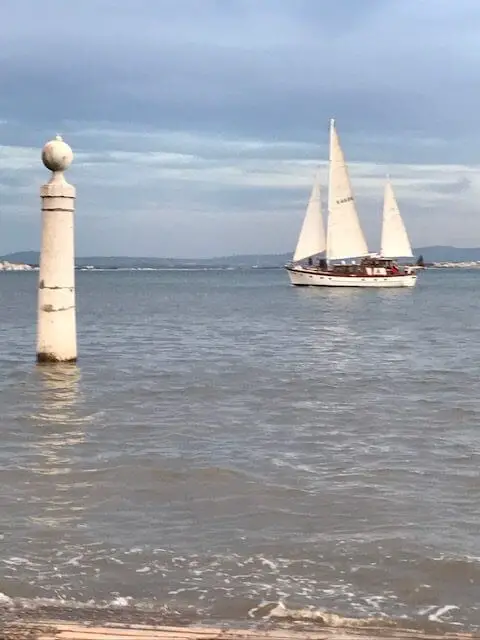
There are several options for enjoying the sunset in the Baixa neighborhood.
Wander down Rua Augusta, where you can shop, eat, or watch street performers. At the end of the street is the magnificent arch (photo at the top of this page).
You can go to the observation deck by entering at Rua Augusta 2.
The viewing platform is open at sunset and has 360-degree views. To learn more about the arch read my What is the story behind Lisbon’s Rua Augusta Arch?
Admission is €8, (free with Lisboa Card). To learn more about the Lisboa Card, see my article Lisboa Card | Everything you need to know
If you go under the arch and cross the street, you will be standing in Praça do Comércio.
Centuries ago, the king built a massive palace on this square, but it was destroyed in the 1755 earthquake.
You will notice two columns jutting out of the river.
There is also a short staircase that descends into the water. This spot is known as Cais das Colunas.
It was a pier that was the former royal entrance to Lisbon.
The stairs and the two columns are all that remain after the earthquake. This is a fantastic spot to sit and watch the sunset.
If you would like to have some drinks as you sit and watch the sunset, follow the river west.
On the other side of the grand Praça do Comércio, you will find Quiosque Ribeira das Naus – a riverfront kiosk that sells food and beverages. For more information on Lisbon’s beautiful kiosks, read my Lisbon’s Kiosks – A popular tradition that you will love
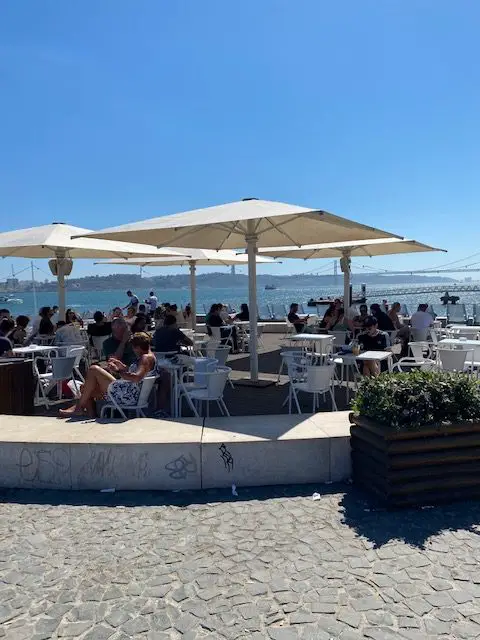
Elevador de Santa Justa
Rua do Ouro, 115.
Opened in 1902,
This 45-meter wrought-iron elevator moves tourists from the Baixa district (downtown) to Largo do Carmo and the Convento de Carmo on the western hill. To learn more, see my Lisbon’s Convento do Carmo Ruins | Everything You Need to Know
The historic elevator (round trip 5.5 euros) has a fantastic observation deck at the top. This would be another great spot for a sunset.
Admission for the viewing platform is an additional 1.5 euros and must be paid in cash.
(Santa Justa is free with Lisboa Card, but the viewing deck must be paid in cash 1.65) For more information on the Santa Justa Lift, Elevador de Santa Justa | Everything you need to know
Looking to go out at night? Try Pink Street
A two-minute walk from Cais do Sodré metro station, Rua Nova do Carvalho is commonly known as Pink Street.
It is one of Europe’s premier party streets.
In the twentieth century, this area was Lisbon’s red-light district.
The brothels and gambling dens were shut down, and now it is a great place to go out and socialize until the early morning.
The street is actually painted pink. To learn more, visit my Pink Street, Lisbon: The Best Bars in Lisbon for Fun
Lisbon 48-Hour itinerary: Day 2
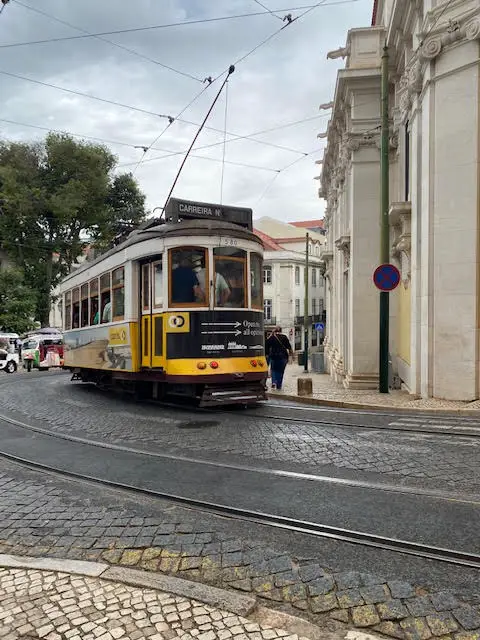
We will begin the second day of the Lisbon 48-hour itinerary with a ride on the famous Tram 28E.
For most of the day, there will be long lines waiting to board the tram. Expect an hour or more wait.
But, the tram starts running at 5:40 am. If you ride prior to 8 am, lines will be much shorter.
It costs 3 euros each way to ride the tram.
It is not free hop-on-hop-off. You have to pay each time you board.
(All rides are free with the Lisboa card, or use a 24-hour public transport card which can be purchased at any metro station.)
Tram 28 starts at Praça Martim Moniz (across the street from the green line Martim Moniz metro station). It will go up the hill through Mouraria and Alfama, with stops at the miradouros. Then it rolls downhill, passes through Baixa and Chiado, and goes to the west side of Lisbon.
You could ride to the end at Campo de Ourique, reboard, and come back to Martim Moniz. Where does Tram 28 stop? All you need to know about Tram 28
Jerónimos Monastery
The Belém neighborhood has three must-see sites.
Luckily, they are all within ¼ of a mile of each other.
In order to get to Belem, take the train from Cais do Sodré headed toward Cascais. Get off at Belém.
Also you can take tram 15E from Praça da Figueira.
You can also take buses 714, 727, and 728.
A taxi from Praça do Comércio should cost no more than 12€.
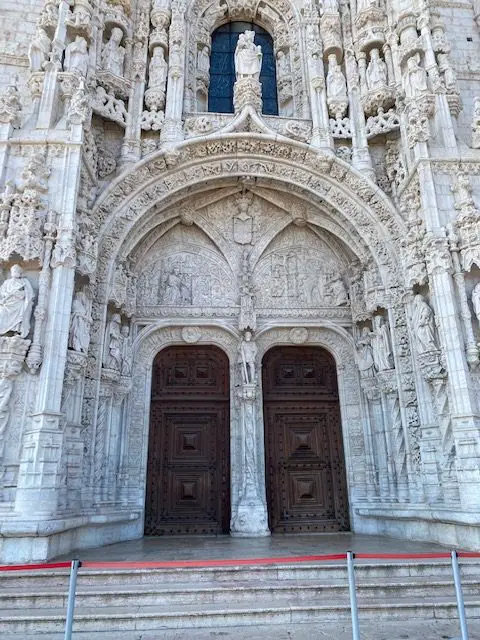
Construction on the Jerónimos Monastery began in 1501.
This 300-yard long building was built using Portugal’s riches from the spice trade.
Built on the site where Vasco da Gama prayed before his first voyage, the monastery was the home of the order of Saint Jerome (the Jerónimos).
Vasco da Gama and national poet, Luís de Camões, are now buried on the site.
It is free to get into the church, but for the rest of the monastery, admission is 10 euros. Don’t miss any of it! The entire site is extraordinary. You can also enter the monastery for free with a Lisboa Card. Is the Jerónimos Monastery worth visiting?
Yes, it is!
Monument to the Discoveries (Padrão dos Descobrimentos)

Across the street from the monastery, you will find the Monument to the Discoveries.
Built in 1958, this monument celebrates the Portuguese Age of Discovery in the 15th and 16th centuries.
The monument resembles the bow of a Portuguese sailing ship, with an assortment of 33 Portuguese national heroes moving toward the unknown.
The figures include Henry the Navigator at the front of the line, Portuguese kings, explorers, cartographers, poets, mathematicians, and artists.
In front of the monument, you’ll find the beautiful and very large Compass Rose mosaic which was a gift from the government of South Africa.
The monument has a museum and viewing deck which close at 7 PM.
Admission is 6 euros for adults, 3 euros for seniors, 12 and under are free. Lisboa cardholders get a 20% discount.
Lisbon’s Monument to the Discoveries | Everything you need to know
Belém Tower
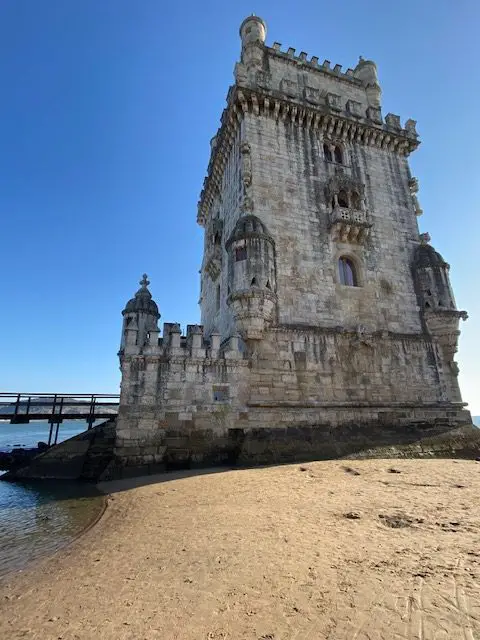
A symbol of Lisbon and a UNESCO World Heritage site, the Tower of Belém, or Torre de Sao Vicente, has been protecting Lisbon harbor since 1519.
Construction started in 1514.
The four-story tower is 98.4 feet tall.
Lunch at the Time Out Market
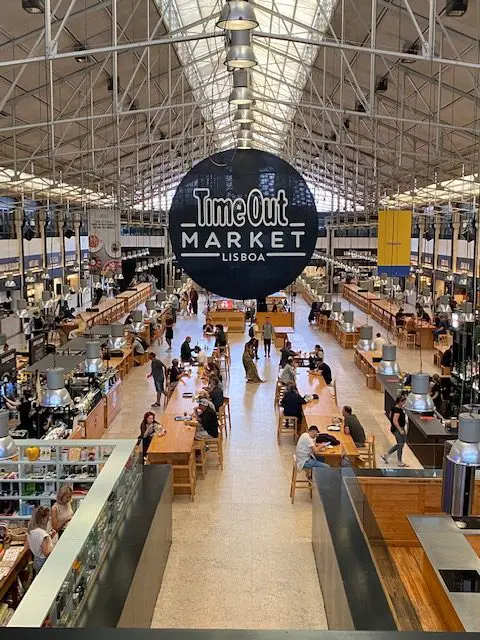
When you finish exploring Belém, take the train back to downtown Lisbon. Get off at the Cais do Sodré station.
Across the street and one block west, you will find the Time Out Market.
There are more than 26 restaurants operating in this food hall – you will find sushi, steak, burgers, traditional Portuguese fare, and seafood.
There are a hand full of bars inside the building as well, pastry shops, a newsstand, and vendors selling locally made goods.
Be sure to check out the attached fish and farmers’ market (Mercado da Ribeira)
Lisbon’s Time Out Market | Everything you need to know
After lunch at Timeout Market, you are very close to the Convento do Carmo and Bairro Alto.
You will find the Elevador da Bica two blocks northwest of (behind) the Timeout Market.
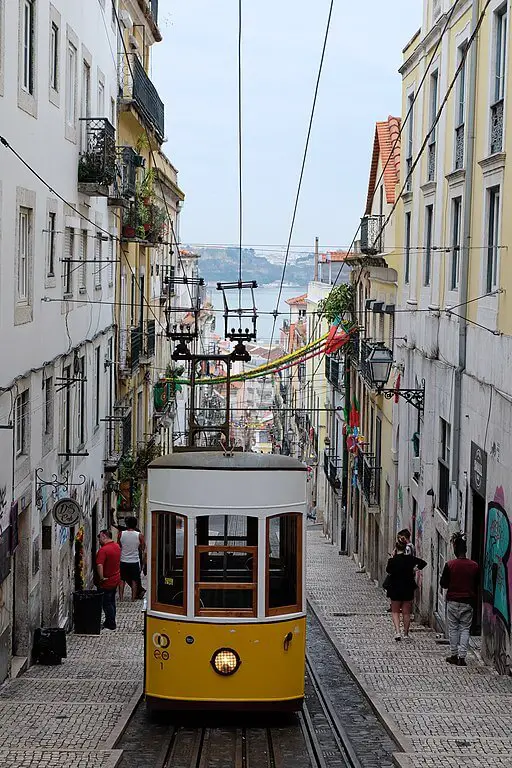
This funicular will take you up the very steep hill to Bairro Alto in a matter of minutes.
This scenic ride is a great place to snap pictures.
The station is at the intersection of Rua de Sao Paulo and Rua Moeda (behind the Time Out Market).
It costs 3.80 to ride the funicular (which allows round-trip, if you want).
You can ride for free with the Lisboa Card or pay using the Viva Viagem Card. The cable car leaves every 15 minutes, and runs from 7 am until 9 pm. For more information, read my Top things to know about the Elevador da Bica
Several blocks northeast from the Elevador da Bica and the Largo da Calhariz is the Convento do Carmo.
Convento do Carmo
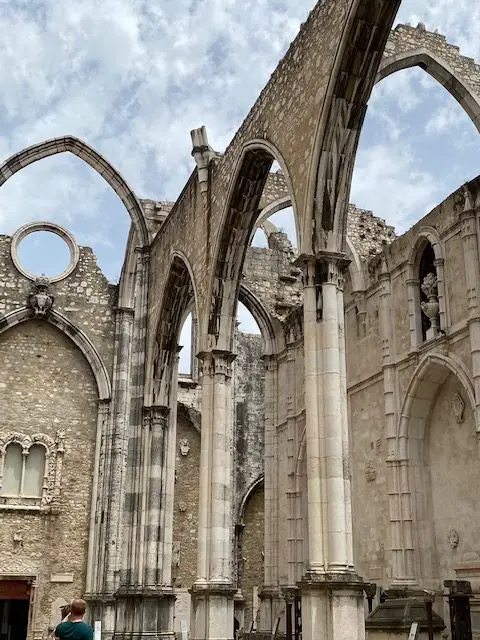
Largo do Carmo
GPS 38.712139, and the longitude is -9.140246
The Carmo Convent was built between 1389 and 1423. The convent’s church was filled for Mass at noon on Sunday, November 1, 1755, when the earthquake struck and brought down the roof.
The church was never rebuilt.
For centuries it has been a reminder of the disaster caused by the strongest earthquake to ever hit Europe.
Today, when you enter the church, you see the walls and the vaulted arches that made up the skeleton of the roof.
This church is one of the most memorable things to see in Lisbon.
Admission is 5 euros. (20% off with Lisboa card)
See my Lisbon’s Convento do Carmo Ruins | Everything You Need to Know
Igreja de São Roque (Church of St. Roch)
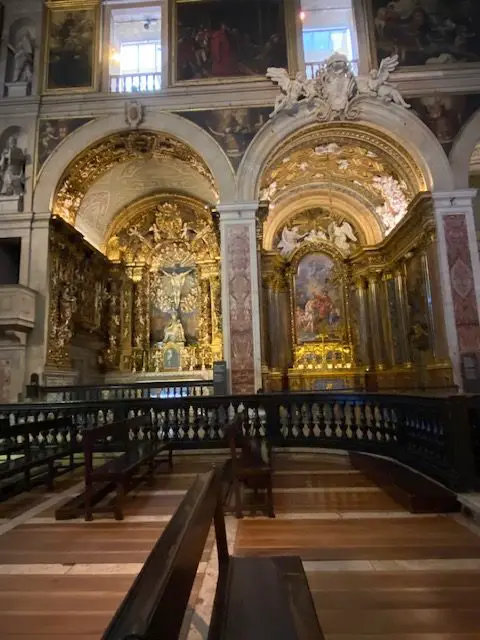
Located just a few blocks north of the Carmo Convent, at Largo Trindade Coelho.
gps coordinates of 38° 42′ 48.6576” N and 9° 8′ 36.4884” W
The Church of St. Roch doesn’t look like much on the outside, but the inside is stunning.
Inside, you will find eight chapels, one of which is the Chapel of St. John the Baptist, which was built in Italy, disassembled, and brought to Lisbon.
It is one of the most expensive chapels ever built.
The ground was broken on this church in 1509, and work continued until 1619. To learn more, see my São Roque Church in Lisbon – What to know before visiting
Miradouro de São Pedro de Alcântara

Not far away is the Jardim de São Pedro de Alcântara and its scenic overlook, or miradouro. To the side of the overlook, you will find an elevator – Ascensor da Gloria which moves people up and down the hill from Restauradores Square to Bairro Alto.
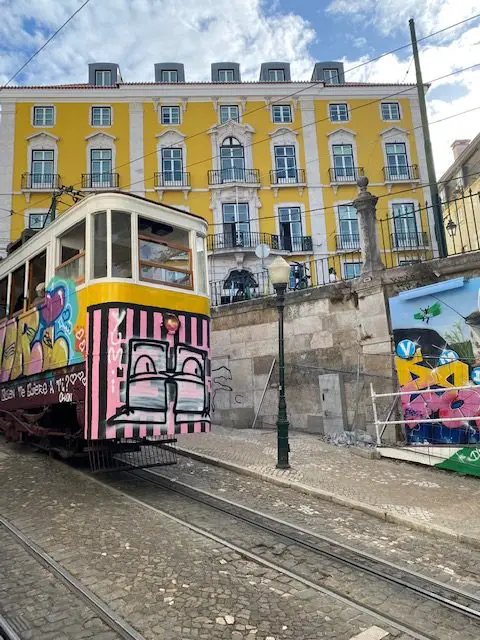
At the foot of Rua Dom Pedro as you turn the corner from the miradouro, most of the restaurants there have a good view while you enjoy your meal.
It is worth wandering around Bairro Alto, maybe looking in the galleries and shops.
Not far from the miradouro, you will find on Avenida Príncipe Real, a beautiful garden (Jardim do Príncipe Real gps coordinates 38.71657,-9.14886), which is a great place to sit around and sip a drink or a coffee with your family and friends.
Check out the boutique shopping mall Embaixada, located at located across the street from the Príncipe Real Garden in the 19th century arabesque Ribeira da Cunha mansion, the shopping center has two floors. Avenida Príncipe Real, 26. See my Embaixada Shopping – A unique shopping gallery in Lisbon
Young, local, entrepreneurs have filled it with local designers, home decor, high-end tailors, art galleries, and pop-up shops.
There is also a gin bar and a garden café.
Sunset in Bairro Alto
For sunset, you could head back near the Elevador da Bica to the Miradouro de Santa Catarina (on Rua de Santa Catarina, gps coordinates 38.7272,-9.14619).
This viewpoint will have views of the Tejo river and the bridge.
Or, you could head back to the Miradouro de São Pedro de Alcântara (not westward-facing, but you will see the golden hour over the Baixa district and have a view of thecastle), or take the Ascensor da Gloria down to the Baixa district and pick one of the sunset options from the day before.
Or maybe sign up for a sunset cruise on the river.
Old and new friends on Lisbon’s Booze cruises and party boats
If you decide to run the streets and socialize at night, Bairro Alto is one of Lisbon’s best neighborhoods for doing that.
You will find no shortage of bars and restaurants to explore once the sun goes down.
Just be careful, if you only have 48 hours in Lisbon, you don’t want to miss your flight!
Summing up 48 hours in Lisbon
Thanks for reading “How to Spend 48 hours in Lisbon – A 48-hour itinerary.”
For me, the must-sees in Lisbon are the castle, and three sites in Belém – the Jerónimos Monastery, the Monument to the Discoveries, and the Belém Tower.
These four sites tell the story of Portugal.
I would also have fresh seafood in Lisbon, and a pastel de nata, or two.
You will have no problem filling 48 hours in Lisbon.
You already have a pretty full and efficient 48-hour itinerary.
To get a peek at what else is possible in Lisbon, see my article 205 Things to do in Lisbon – The Ultimate Guide
Know that I am not affiliated with any business or organization mentioned on this page.